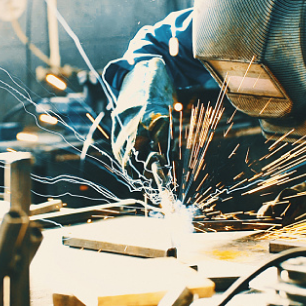Jump to:
A Practical Guide to Submerged Arc Welding
Submerged Arc Welding (SAW) isn’t flashy—it literally operates under the surface—but when it comes to heavy-duty performance, this process does the heavy lifting. From structural steel to shipbuilding, SAW is the go-to for high-deposition, high-productivity welds that demand consistency and quality.
What Is Submerged Arc Welding?
Submerged Arc Welding is a fusion welding process where the arc is struck beneath a blanket of granular flux. That flux isn’t just for show—it shields the weld from atmospheric contamination, stabilizes the arc, can act as a deoxidizer, and even contributes to the metallurgical properties of the finished joint. The result? Deep penetration, minimal spatter, and smooth weld beads that often require little to no finishing work.
Unlike processes like Shielded Metal Arc Welding (SMAW), SAW is almost always mechanized or automated, making it ideal for long, continuous welds in high-volume production environments.
The SAW Process: How It Works
Here’s the basic setup: a continuously fed electrode (either a solid or cored wire) travels through a welding gun and into the weld zone beneath a mound of flux. The electric arc forms between the wire and the workpiece, melting both the base material and the filler wire.
As the arc does its job, the flux melts too—part of it becomes slag and part of it forms a protective gas. Any unused flux can be collected and reused, which keeps waste and cost down.
Essential Equipment for Submerged Arc Welding
To run a Submerged Arc Welding system, you’ll need a few key components:
Power source: Usually DC, although AC and AC variable polarity AC is used for specific applications.
Wire feeder: Keeps that electrode moving steadily into the weld.
Flux delivery system: Deposits and often recycles the granular flux.
Travel carriage or gantry: Provides motion, whether it’s along a seam or around a vessel.
Advanced Submerged Arc Welding systems often integrate programmable controls to dial in exact parameters for voltage, current, wire feed speed, and travel speed—an essential feature for projects requiring repeatability.
Applications That Play to Submerged Arc Welding’s Strengths
SAW shines in industries where long welds and thick materials are the norm. Think:
Structural steel fabrication
Shipbuilding and offshore platforms
Pressure vessels and storage tanks
Pipe mills and large-diameter pipelines
In these settings, the process dramatically boosts productivity, thanks to deposition rates that far outpace manual methods and weld quality that meets the most demanding standards.
Why Choose SAW?
If your operation needs efficiency, repeatability, and strong welds on thick materials, SAW delivers:
High deposition rates
Low spatter and cleanup
Excellent mechanical properties
Reduced operator fatigue (thanks to automation)
Of course, SAW isn’t ideal for every scenario. It’s typically limited to flat or horizontal positions and requires upfront investment in equipment. But for the right applications, it more than pays for itself.
Want to learn more about submerged arc welding or browse SAW-ready equipment and resources?
Check out the AWS standards and publications, explore training and certification options, or become a member to stay current with the latest in welding advancements.


